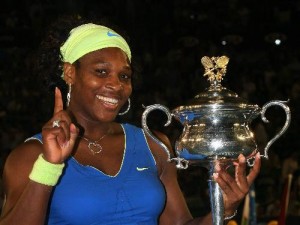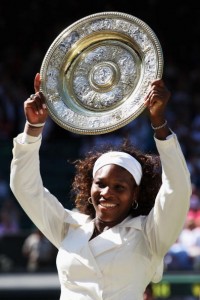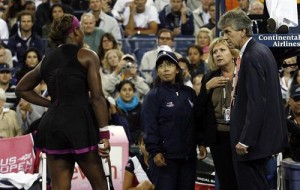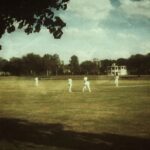How She Fared in 2009: Serena Williams, Nearing Legendary Status

Sererna Williams began 2009 by winning her fourth Australian Open title.
The Serena Slam took place in long ago 2002-2003 (leading to major titles No. 2-7; a win of five major titles in six Grand Slam events).
Then came injury, a sister’s murder, a notorious match of atrocious line calling that knocked her out of the USO in 2004, and a slip to No. 81 ranking. Poor performances. Criticism for being AWOL from segments of the tour.
Then, a triumph. A Grand Slam win in the Australian Open in 2007 (major title No. eight) that saw Serena hit a resurgence in her career. In 2008, the retirement of a major rival; the finals of Wimbledon; a win at the USO (major title No. nine), (not to mention continuing doubles’ titles including yet another Olympic gold medal) led to a simmering argument over who is the “real” world No. 1 on the Women’s Tour.
2009
Coming into the Australian Open, the usual criticisms abounded. Serena didn’t look very good in Sydney in January (losing to Dementieva 6-3 6-1). In fact, Serena looked “fat”—like she could bench press a dump truck (paraphrasing humorous remarks by Andy Roddick exchanged on camera because Serena claimed she had beaten Andy when he was 12 years old), and the press pestered her about being out of shape, overweight, and not ready for the majors. These (very funny remarks) can be seen here.
The top ladies in the draw included photogenic and personable stars: Jancovic, Ivanovic, Dementieva, also Kuznetsova, and Safina. Super-photogenic and telegenic star Maria Sharapova was still nursing the shoulder injury that would keep her out of the tour for about eight months.
The biggest challenge to Serena at the AO would prove to be Kuznetsova, who would be two points from a major win, but see the whole thing slip away in the third set, and lose 5–7, 7–5, 6–1.
The final would pitch Serena against Safina, who was then currently ranked No. 1, and who looked very good. On paper, the match had the makings of a knock-down drag out battle for No. 1. In fact, it was all over in an embarrassing 59 minutes [6-2 6-0] as Safina displayed her emotional frailty and was steam-rolled. In-form Serena collected major title No. 10.
Serena emerged from this match with the No. 1 ranking. Jankovic and Ivanovic, would both sink drastically in the rankings, Ivanovic telling the press what a disappointing year it was turning out to be for her.
Serena would not be seen again until Miami, as they do not play the Indian Wells event, where she would lose the final to Azarenka.
Clay Season
On clay, Serena lost her opening match of every single tournament. When asked about the number of Russian ladies in the draw, she joked that she thought she was Russian too—just call her “Williamsova.” She lost the FO quarterfinal to eventual champion Kuznetsova 7–6 (4), 5–7, 7–5.
Grass
Serena and Venus did not play a warm-up event, but went straight into Wimbledon as the No. 2 and No. 3 seeds, respectively. Maria Sharapova was back, and Jancovic and Ivanovic had dropped to No. 6 and No. 13, respectively.
Serena steam-rolled through the draw until she met up with Dementieva in the semifinal. Though Dementieva had struggled in the early hardcourt season (losing in the second round at Indian Wells), she was in top form for Wimbledon. Her forehand was firing on all cylinders, her footwork was working, and most importantly, her serve, and timing, were effortless.

Serena claimed her 11th major championship with a win at Wimbledon.
In one of the best matches of the year, Elena kept Serena moving front and back as well as side to side. But Serena was in the best form of her career, hitting groundstrokes with the usual power, but as accurate as some of the legends of the sport. If she was “bench pressing dump trucks,” it showed in the power she was able to deliver, pushing Elena off the court. She staved off match point, and defeated Dementieva 6–7(4), 7–5, 8–6.
The final would include yet another battle with her sister for the Venus Plate (Venus would be looking for her 6th Wimbledon singles title). Venus said that she signed up for Twitter specifically to follow Serena’s regular “tweets” about her on-court strategy. But it didn’t help. Venus was flat in the second set, and in a somewhat anti-climatic match, after the barn-burner semifinal, Serena defeated her in straight sets, collecting major title No. 11.
At the press conference, Serena wore a T-shirt over her ample bosom that read: “Are you admiring my titles?”
Summer, 2009: Injury-This; Injury-That
Ankle; thigh strain; hip. Serena looked to be in doubtful form for the USO, and lost early in every warm-up event (just as she did for the FO). Safina was ranked No. 1. And Kim Clijsters, former USO champion, and retired mother of a 12-month-old girl, decided to return to the tour.
Serena by now was laughingly telling the press that “we all know who the real world No. 1 is …” (in a little gamesmanship with rival Safina, who clearly struggled with the pressure of the big tournaments and being No. 1 without having won a major).

Seerena's impressive 2009 season was somewhat overshadowed by her meltdown at the U.S. Open
But as with the FO, Serena stormed through the draw making mince-meat of her opponents, and her biggest (only real) competition, as the tournament drew to a close, would be Kim Clijsters in the semifinal.
With a win in the 2009 USO, Serena would have collected twelve major titles, and as a result been tied with some of the legends of the sport, such as Billie Jean King, and Suzanne Lenglen—both of whom have major tennis centers named after them.
Late in the third set, Serena had a foot fault called on second serve, resulting in two match points for Clijsters. The call was dubious at best, because it cannot be seen on the replay. Serena reacted with both verbal abuse and physically intimidating gestures toward the line judge, for which she drew an unsportsmanlike conduct penalty—her second, as she had already received a racket abuse penalty earlier in the match—and so she lost the match on penalties. She was also fined about one hundred thousand dollars en toto.
Serena has no one to blame for this but herself. But it is unfortunate for, as with the Wimbledon semifinal, Serena has shown many times that match-point down is not necessarily the end for her. It is easy to envision her winning the tournament if she would have been able to stay emotionally contained after the foot-fault call.
Year-End Champion
Serena was healthy, and played the season ending championships in Doha, one of the few years that she has done so. She advanced with a win in all of her round-robin matches—defeating Kuznetsova, Dementieva, and Venus (where she yet again saved match point), and defeated Venus again in the final, to emerge as the winner of the WTA Season Ending Championship.
Conclusion
Along with 2002-2003, and 2008, 2009 was an outstanding year for Serena. She might not have been “cute” and she might not be as photogenic as others on the tour, but she had the game. And she wrote a book! [Serena Williams My Life: Queen of the Court Publisher: Simon and Schuster]
2010 should be even more interesting as one of Serena’s major rivals, Justine Henin, returns to the tour.
All the great champions of the sport have elements of their game that goes beyond the “cute” and perky. A competitive fire, an inferno of desire. There’s steel beneath the outward smiles.
I close this article with a summary of the major Ladies’ Champions of the sport, and leave it to the interested reader to contemplate where Serena might end up at the end of her career.
__________________________________________
Summary of legends of the sport:
- Lenglen: 12 Grand Slam singles Titles (all surfaces); 1920 gold medal
- BJK: 12 Grand Slam singles Titles
- Evert: 18 Grand Slam singles Titles
- Navratilova: 18 Grand Slam singles Titles
- Wills: 19 Grand Slam singles Titles (all surfaces); 1924 gold medal
- Graf: 22 Grand Slam singles Titles ; 1988 gold medal
- Court: 24 Grand Slam singles Titles













